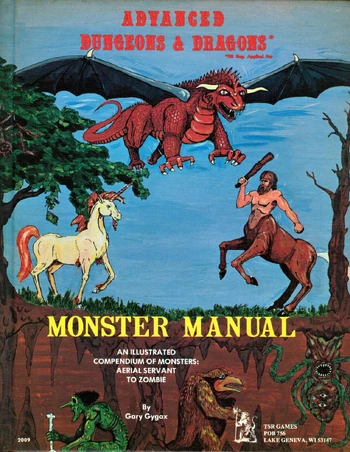 So this time around, we're going back to 1978. So far we've been talking about the 5th Edition Sourcebooks, talking about the rich history of the monsters that have been deemed as 'classics'. Like the Mind Flayers and the Beholders, and the chromatic and metallic dragonkin, and how gnolls and goblins and kobolds have been around since forever.
So this time around, we're going back to 1978. So far we've been talking about the 5th Edition Sourcebooks, talking about the rich history of the monsters that have been deemed as 'classics'. Like the Mind Flayers and the Beholders, and the chromatic and metallic dragonkin, and how gnolls and goblins and kobolds have been around since forever.But what about their very, very first appearances? What about the very first edition and the very first Monster Manual, which was published all the way back when Gary Gygax and Dave Arneson finally finalized their "Advanced Dungeons & Dragons" product after various prototypes for "Dungeons and Dragons" were released in the years preceding? Well, I thought I'd take a look at the very first Dungeons & Dragons bestiary sourcebook, the Monster Manual, a collection of many monsters released in the original 1974 Dungeons & Dragons product. (I know, it's a bit confusing -- just accept that this is the first Monster Manual ever and we'll move on).
And it's really kind of interesting. I'm not very familiar with the rules of 1E, and I freely admit it, but just looking through the 2012 reprinted edition of the AD&D 1E Monster Manual and looking at the funky artwork and the somewhat typewriter-esque font, and sometimes very... numbers-driven description. It's clearly meant to be a textbook, and for the most part... they're very dry. The Monster Manual escapes it and becomes a bit more interesting because it's describing monsters and even the most bogged-down description of monsters is still pretty neat, but it's clearly a product that I'm not the target audience for, having been mostly more familiar with 4E and 5E that are a bit more simplified.
It's genuinely interesting to see just how much of the lore for these creatures have changed significantly and/or stayed the same over four decades of publication. And, of course, despite the slavish attempt to have most monsters from 1E's Monster Manual appear in every edition, it's actually interesting just how there are a couple that are... sort of left by the wayside. Anyway, this time around, we'll be mostly covering the creatures we haven't talked about before, and likely will never talk about outside of 1E, as well as a couple of creatures that haven't shown up in 5th Edition yet.
This article has recently been edited and I've moved around the creatures that have representation in Volo's Guide to Monsters there, namely the Catoblepas, Ki-rin, Leucrotta, Trapper, Lurker, Rot Grub, Slithering Tracker
- Click here for the previous part, covering the 5th Edition Monster Manual Appendix and PC races from Volo's Guide to Monsters.
- Click here for the index.
Aerial Servant
Our very first monster in 1E's Monster Manual is a creature that has never shown up, at least not in this exact form, in any subsequent publications. It's the Aerial Servant, and, no, there isn't any artwork for me to show here. 1E's Monster Manual didn't have artwork for all of its entries. The Aerial Servant is essentially described as a somewhat more intelligent version of an air elemental, and is conjured by cleric enemies. They're noted to not technically be combatants, and are compared in-prose to the Invisible Stalker, another "invisible semi-intelligent air elemental" enemy. Except, of course, the Aerial Servant acts more like, well, a servant of its master, although if they get frustrated, they basically end up going on a Hulk-like rampage. The Aerial Servant's basically sort of reduced in future editions as a spell, and renamed as Carbury's Servant (2E) or Unseen Servant (3E and 5E), where the Unseen Servant spell ends up being a spell that's associated with wizards and bards. Overall, I can see why they didn't really print this creature as a monster in subsequent editions, considering how kinda redundant it ended up being.
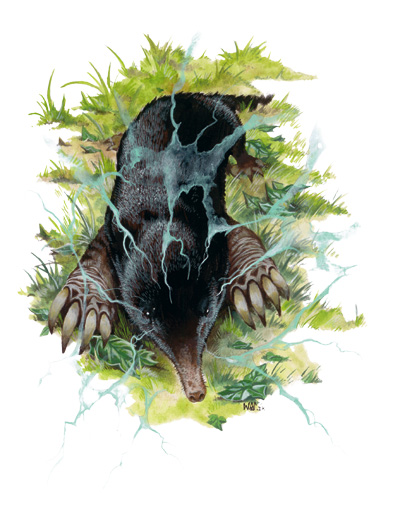

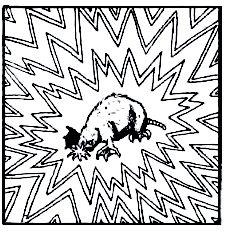
Brain Mole
And here we go, here's one of those creatures that is sort of forgotten after a while. The Brain Mole survived long enough to show up in 2nd Edition's Monstrous Manual, and in 3E's Psionic Handbook, but was sort of ultimately ignored throughout subsequent publications. And... yeah, sometimes life's like that for the weird and wacky D&D monsters, y'know? Sometimes you have the Axe Beaks and Brain Moles of the world, who are just weird-looking animals with an extra feature or two, who tends to crop up in appendixes. And the Brain Mole's just a star-nosed mole (or a regular mole in 3E) who feeds on psionic energy, and will want to feed on anyone using psionic abilities by 'burrowing' into the mind. In a psionic sense, of course, not a literal one. Mostly, this just causes insanity. And I kind of sort of get what they were going for -- it's a 'burrowing' attack into the mind, and it's a mole, but it's way of attacking is perhaps a bit harder to replicate in some battle systems, and other than that one singular gimmick, the Brain Mole's just... there. I feel like they could've done something to reinvent or reinvigorate the Brain Mole, though. Make it part of a wizard's arsenal, or maybe turn it into some sort of a pet for mind flayers or something, as opposed to just "it's a mole that feeds telepathically somehow". Although I guess with Intellect Devourers and the like, the Brain Mole is just utterly and absolutely outclassed in the cool and creative factors.

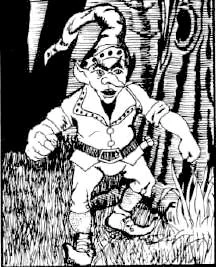
Brownie
Remember how I talked about how there's a lack of variety among the fey creatures? Well, back in some older editions like 1E, it's not that there's just a lack of variety, it's also the fact that there's a lot of fey creatures that are essentially the same thing. Take the Brownie, for example, which at one point was a term for a British faerie that helped to clean your house in exchange for milk, and not a baked chocolate cake. In 1st Edition, brownies are half-halfling, half-pixies that are friendly, but... well, that's about it. They can hide into the background, and can repair wood, leather or metal, something that isn't super-useful in terms of a D&D campaign. Plus, everything they can do is sort of redundant compared to other races in D&D like the gnomes and like literally most other fey creatures out there. I do kinda wished we had some sort of update to the Brownie that gave it its own identity, but this is one creature that I'm not surprised they didn't try to update in subsequent editions.
Cerebral Parasite
Another creature that didn't get any official artwork, the Cerebral Parasite was also a creature that didn't survive long after 1E, being a bit of a footnote in 2E's Psionic handbook before being completely ignored throughout the entire run of the franchise. Again, like the Brain Mole, it's another psionic-themed monster, this time one that's a lot better-themed. It's an invisible parasite that can only be detected by psionic means, and they insidiously latch on to psions and their only effect is felt when the psions try to use their abilities, continually replicating as it feeds on their energies. The fact that the player doesn't even know about the Parasite is kind of a dick move, and the fact that we didn't even really get any sort of lore other than how it fucks up your party's psionic-using members does mean that the Cerebral Parasite ends up coming off more like a pretty assholish trap as opposed to an actual adversary.

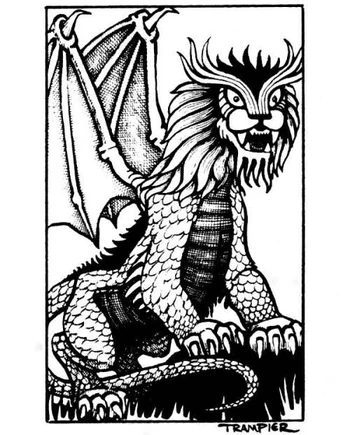
Dragonne
I could've sworn the Dragonne shows up in a lot more editions than just 1E and 3.5E, but I blame that on me spending a lot of time through 3.5E's Monster Manual as a kid. And the Dragonne is one of the many different dragon variants, and perhaps one of the more redundant ones -- it's basically a small dragon with the head and features of a lion, something that does look pretty neat, but ultimately... well, kind of redundant with chimeras and many other lesser dragons running around, I suppose? I still find that it's neat, but other than its relatively neat-looking design (which, again, is sort of undercut by the various lion-hybrids and dragon-hybrids out there in D&D-land) all the Dragonne's got going for it is a paralytic roar. Overall, it's kind of a shame that the dragonne doesn't quite hang around the way the owlbear did. Shame, I did really like that 3.5E artwork.
Ear Seekeer
One that showed up only in 1E and briefly as a footnote in an Al-Qadim book for 2E, the Ear Seeker is essentially an earwig, but with all of the tall tales and creepy stories about it laying eggs in someone's ears made manifest. And it's a creepy creature, for sure, but there's otherwise not much going on other than "yep, earwigs in D&D-land are creepy". It's definitely kind of a huge, huge dick move for your DM to throw one of these at your characters, because it's not even like a Slaad or a Mind Flayer where you're sort of thrust into an Alien like situation. You just fall asleep somewhere dirty, an evil earwig mutant lays eggs in your ear, and, in the words of the MM, "the larvae eat the surrounding flesh, ...killing their host 90% of the time."
Floating Eye
Despite its name, no, the Floating Eye is not a Beholder, or a floating eye. It's just... a transparent fish with a single large eye. Sort of like a highly exaggerated version of a Barreleye Fish in real life, but the Floating Eye is able to unleash paralytic beams from its eyeball. The brief description that the Floating Eye has a symbiotic relationship with other larger fish is... is somewhat interesting, but ultimately it does end up coming off as a bit too gimmicky, and I can see why this one never quite caught the heart of the masses.
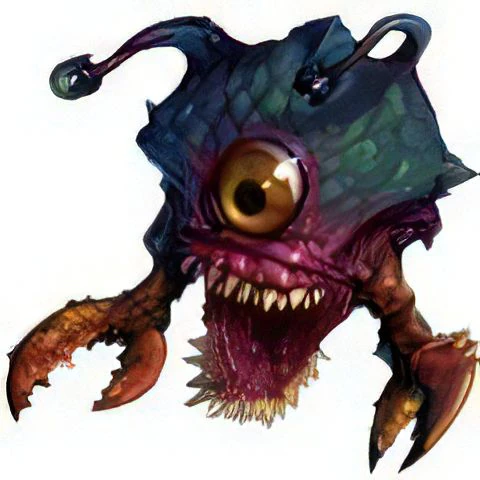
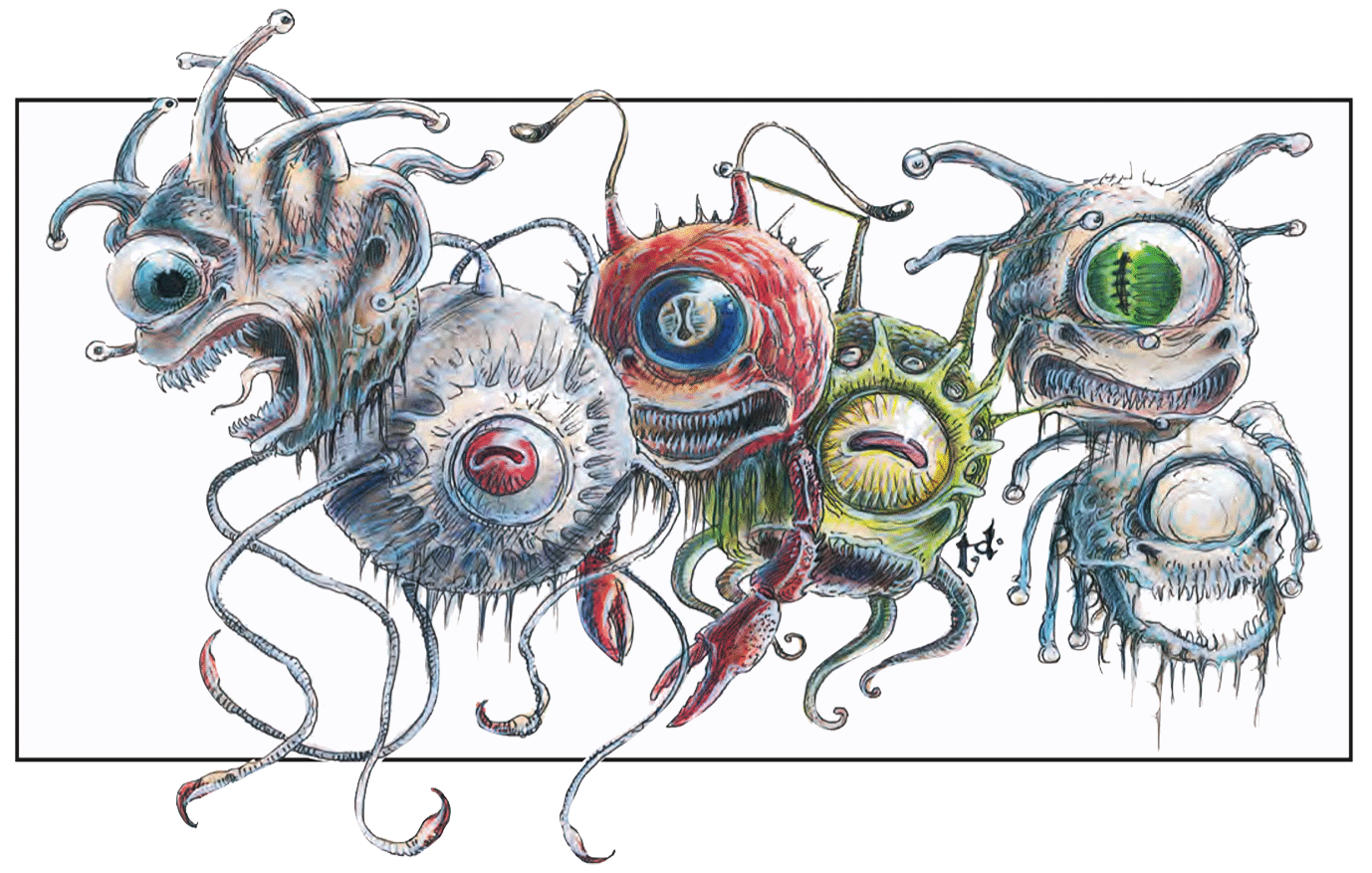
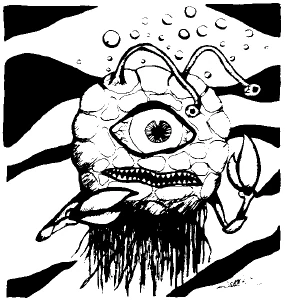
Eye of the Deep
The Eye of the Deep is introduced in 1E as a 'possible' relative of the Beholder, due to their similarities, and in subsequent appearances in 2E and 3E, are straight-up noted to be a Beholder variant. The difference, of course, is that it has significantly less tentacle-eyes, reducing them to only two snail-antenna like protrusions, but has two massive crab claws and a mustache similar to a jellyfish's tendrils. Okay! The Eye of the Deep's... kind of an interesting variant, but sort of fell by the wayside considering other Beholder variants tended to be more interesting than "it lives in the water and has crab claws". I do feel like it's interesting enough, but maybe they wanted more unique underwater creatures? Like all other Beholderkin, the Eyes of the Deep essentially regard themselves as the perfect kind, and all those land-dwelling fools are clearly inferior beholders.
(In that 2E artwork, the Eye of the Deep is the third from the left, the red dude with the slightly-baffled expression)
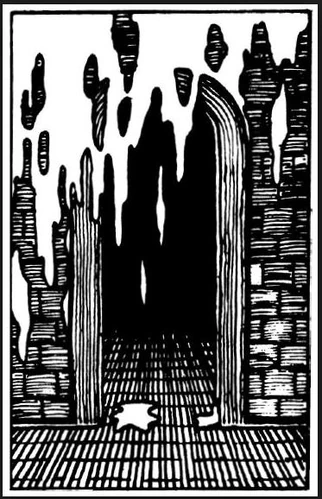

Green Slime
All of the original D&D oozes, only one doesn't show up in all subsequent editions, at least not as a proper monster. The Green Slime is treated more of an obstacle or a hazard, and tended to be shunted in descriptions of traps and the like in like adventure modules or the Dungeon Master's Handbook. And, well, unlike the Gray Oozes and Black Puddings and Ochre Jellies and Gelatinous Cubes of the world, the Green Slime is perhaps the most boring, just noted to be 'strange plant growths' that can't move, and just drop upon any unsuspecting prey and eventually dissolve whatever humanoid it falls upon into more green slime. It's certainly an interesting gimmick, but kinda lacking compared to the other oozes in D&D land. And, y'know, at least it's not entirely gone, just reduced to a generic acidic enemy.
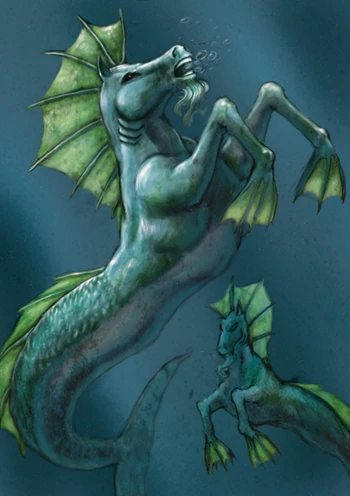 Hippocampus
HippocampusConsidering how happy the subsequent editions are to print entries for griffons, hippogriffs, pegasi, unicorns and nightmares, their poor, poor water-dwelling cousin the Hippocampus (based on the Greek myth monster of the same name) just never made it out of 2E, sort of being reduced to a brief, easily-missed side-note in most subsequent editions. And... well, it's just a horse with fins at the tip of their horse legs and giant mermaid-like fish-tails, which, again, admittedly doesn't make for the most interesting creature. Which... to be fair, it does seem more to be like an accessory to water-dwelling creatures like sahuagin or tritons. I kind of am sensing a pattern that most of what ended up being cut out of the 1E Monster Manual tended to be aquatic creatures. Which, fair enough, underwater adventures are a bit hard to regulate, but at the same time it's genuinely surprising that so many of these never made a return in random supplementary books, y'know?
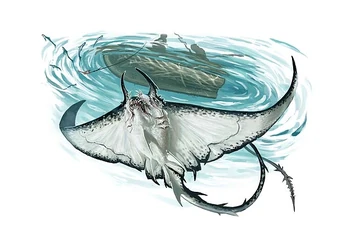
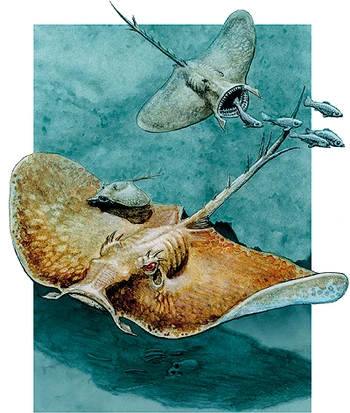
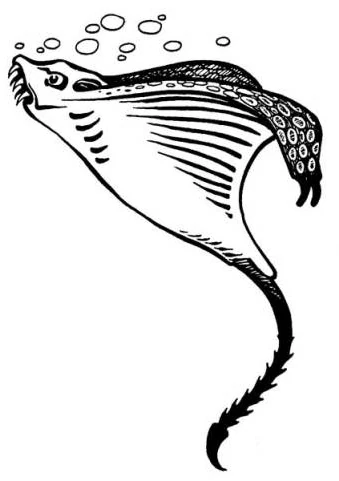
Ixitxachitl
YES. Now, this aquatic beast was not ignored, appearing in almost every single edition. It shows up in the original 1E Monster Manual, the Monstrous Manual for 2E, in the second Monster Manual for 3E, in the Demonomicon for 4E and finally, in the adventure Out of the Abyss for 5E. I am not sure how I'm going to handle the 5th Edition adventures, so I'm just going to go through all the monsters in 1E that I haven't talked about through my sojourn of the 5th Edition Monster Manual.
| Ixitxachitl (5E) |
4E and 5E ended up revamping the Ixitxachitl, taking the term "Devil Ray" in a surprisingly neat manner. It's got a massive, growling shark-like fanged mouth instead of the comical mouths that rays are associated with, it's got a sleeker, meaner-looking body, plus its manta ray mouth-lobes are now shark, pointy devil horn things. It's a pretty neat design that communicates the idea of a monstrous manta ray pretty well. In both 4E and 5E, they are described as being worshipers of (or straight up created by) the demon prince Demogorgon. Again, I do like the update for these monsters. Sure, they might've gone a bit overboard, but I do like that the general silhouette of the Ixitxachitl still looks enough like a normal manta ray that the whole gimmick of them being disguised as regular rays is still pretty feasible. It's frankly not the most creative monster out there, but I do like it more than I perhaps should.

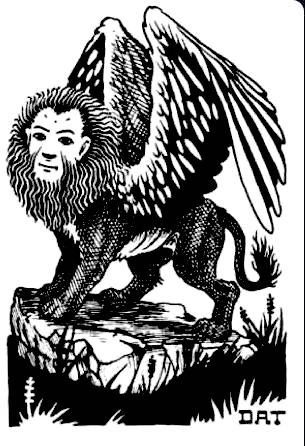
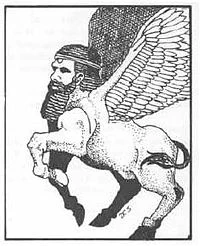
Lamassu & Shedu
| Shedu (2E) |
I'm going to also group the Shedu in the same place here, because the Shedu is based on a similar Assyrian deity, a counterpart of the Lamassu. The Shedu in D&D are basically depicted as having the bull-bodied versions of the mythological deity, and its artwork does make it feel more like something out of Assyrian legend as opposed to the Lamassu's art pieces. The Shedu is basically the same thing as the Lamassu in D&D, though, albeit with extra plane-shifting and psionic abilities. Overall, the two are kind of... well, they're kind of boring, and a lot of what they can do isn't super-duper interesting compared to the other 'winged lions' or 'lions with human faces'.
Leprechaun
Another one of the many fey creatures that really never showed up after 2E, I can't even really find any cropped artwork for the 1E/2E Leprechaun online, and couldn't be arsed to do the scanning myself. Leprechauns are... well, they're basically what you expect from the Irish faerie, really. They're small, they're mischievous but not evil, they play tricks, and can be tricked and/or trick you. I really don't have much to say here, they're honestly kinda boring. Again, while I wouldn't mind them showing up, I do kinda wished that if they do, the writers at least try to do something to make them feel more unique. Y'know what? I guess it is a pretty smart decision for 5E to cut down the humanoid fey to basically just pixies and sprites.

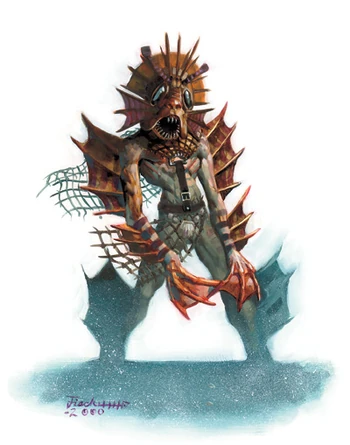
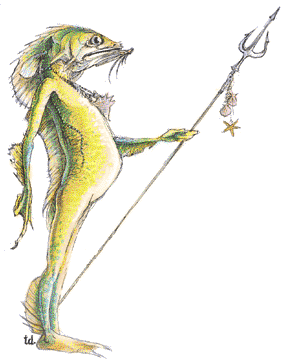
Locathah
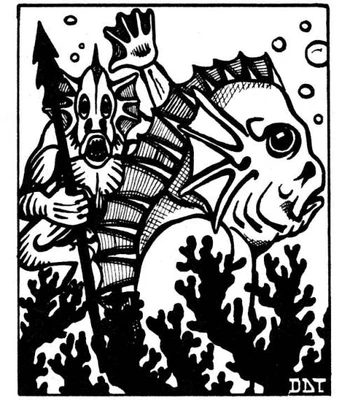 D&D has a lot of fish-people, huh. The Locathah is perhaps one of the less-consistently portrayed one. 1st Edition just had them be humanoids with the heads of fish, and 2E did the same thing, albeit giving them a far longer underbite with barbels. Plus a pot-belly for some reason. This... sort of ended up clashing with how the Sahuagin and Kuo-toa ended up being portrayed, becoming somewhat redundant, I suppose? 3rd Edition went all-in in making them monstrous, and I actually really like the artwork, with the red fins, the dead eyes, the huge crown and the blade-like fins on its arms. That's pretty cool! But 5E gives us perhaps the most adorable Locathah ever, just... just a dumb-looking fat fish with fin-legs and thin human hands. I'm genuinely torn on whether I like the deep-sea-terror 3E Locathah better or the adorable buddy from 5E. It's always the oceanic creatures, huh? I guess the 5th Edition revamp is there to give the Locathah a unique niche among the friendly (merfolk), proud (triton), scary (Sahuagin) and crazy (kuo-toa) fishmen.
D&D has a lot of fish-people, huh. The Locathah is perhaps one of the less-consistently portrayed one. 1st Edition just had them be humanoids with the heads of fish, and 2E did the same thing, albeit giving them a far longer underbite with barbels. Plus a pot-belly for some reason. This... sort of ended up clashing with how the Sahuagin and Kuo-toa ended up being portrayed, becoming somewhat redundant, I suppose? 3rd Edition went all-in in making them monstrous, and I actually really like the artwork, with the red fins, the dead eyes, the huge crown and the blade-like fins on its arms. That's pretty cool! But 5E gives us perhaps the most adorable Locathah ever, just... just a dumb-looking fat fish with fin-legs and thin human hands. I'm genuinely torn on whether I like the deep-sea-terror 3E Locathah better or the adorable buddy from 5E. It's always the oceanic creatures, huh? I guess the 5th Edition revamp is there to give the Locathah a unique niche among the friendly (merfolk), proud (triton), scary (Sahuagin) and crazy (kuo-toa) fishmen.1E Locathah are portrayed as simple nomads that ride giant eels, and doesn't offer much lore beyont the fact that they were nomadic fish-people. I cracked open my 3.5E Monster Manual, and other than the cool artwork, we really don't learn much new information about the Locathah, noting that despite their mistrust of surface-dwellers, they're not hostile unless attacked first. 5E, meanwhile, prominently stars them in the Ghosts of Saltmarsh book, and, more recently, the .pdf product Locathah Rising... which is an adventure where you play as a Locathah, plus rules to make the Locathah a playable race. Which is pretty neat! They are adorable fish people. I haven't had the opportunity or chance to purchase or peruse said book, but from what I can gather from both Ghosts of Saltmarsh and what I've heard, the Locathah is characterized as a race that has recently broken free of war and slavery by asshole sea-races like the Kuo-toa and the Ixitxachitl, and they're just sort of trying to make their own lot in life. They've basically blamed their fragmented infighting as why they were enslaved, and now they are basically very close-knit among their own kind. Neat! Overall, I just really like how they look.
Masher
The Masher is... it's a "worm-like fish" that eats coral, and it's got a bunch of poisonous dorsal fins. And that's about it for the Masher. I guess the name refers to how it 'mashes up' coral? The concept is neat but ultimately somewhat boring, y'know? It's got no pictures, a very minimalistic write-up, and honestly, I can't blame most players and the game creators for completely forgetting this creature exists.
Mold
I was about to move on to the next entry in the Monster Manual when I saw "Mold". Like, okay, it's like real-life mold, probably just a bunch of mushrooms that rots things or something, right? But apparently 1E's mold does kind of constitute as an assholish threat to adventurers. The Yellow Mold is kind of mundane, just digesting through anyone who touches it, and sometimes it unleashes spores that asphyxiate foolish adventurers. It's only harmed by fire, because, well, the Pokemon rules of Fire-beats-Grass. Or, well, fungi. But then you've got the Brown Mold feeds on the body heat of anyone who passes through, and will even consume the heat from torches and fireballs, which seems to be kind of a property to trick anyone who goes through the "it's a plant-like thing, let's burn it!" mentality, which would instead cause a fire-eating-mold apocalypse. It's noted that magical cold, and only magical cold, can put a brown mold into dormancy. Oh, and a big enough mold colony will have a chance to develop sentience and have psionic powers. The idea of a mold-based monster that grows and grows is neat, but perhaps the execution that relies mostly on tricking the players is what made this creature basically fall on the wayside of the many gimmick monsters out there. They are basically reduced to just 'hazard' encounters in subsequent editions, and at the very least, I know they make an appearance in 5E, albeit relatively altered to just doing mere poison damage over time.
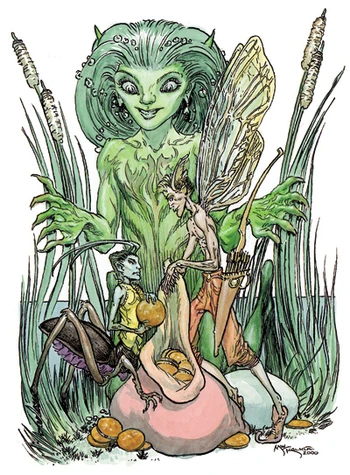
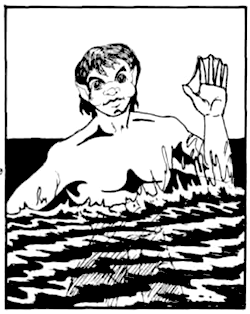
Nixie
(In the 3E artwork, the Nixie is the larger green fairy looming over the other grig and the pixie). The Nixie is yet another one of those humanoid fey creatures, this time being a water-themed variant of the Sprite. And... and that's about it, really. They're just small humanoids with webbed fingers that live in lakes. In 1st Edition, though, they're just evil fey who delight in enslaving humans, while in 3E they're just one of the many reclusive-and-suspicious-of-humans fey. It's kind of a shame, really, since the original legends of the Nixie had a lot of features like shapeshifting, a charming song, and a desire to drown mortals. Considering the low amount of actually just straight-up evil or malicious fey, I feel like with a bunch of more appropriate artwork and flavour, the Nixies definitely has the potential to be far more interesting as adversaries.
Nymph
 |
| Nymph (3.5E) |
Another water-themed fey who saw a fair amount of appearances, having appeared in 1E, 2E, 3.5E and technically 4E (4E's Nymphs are super-different) is the nymph, and I could've sworn up and down that I've seen them in a 5th Edition sourcebook... but apparently, as of the time of writing, they haven't shown up in 5E yet. There's definitely a fair of overlap with Dryads in the depiction of the nymph, but I do like that there's a fair bit more to the Nymph than just "Dryads, but in lakes instead of trees". And unlike dryads, who looked like pretty women but made up of (or covered with) plant matter, nymphs were just straight-up half-naked sexy elven women, but with a catch! Looking at a nymph will cause permanent blindness if the nymph doesn't want you to see her, and if you see her nude, 1E's Monster Manual describes that "an onlooker will die". Death by nudity! Nymphs are capricious and reclusive, and their disposition depends on the alignment of the mortals approaching her, liking good-aligned people, elves and druids. And "males with a charisma of 18", according to the 1E. They're another one of those creatures that isn't here just as a stat block for your party to DPS down, but an interesting encounter that might be fun to RP out.
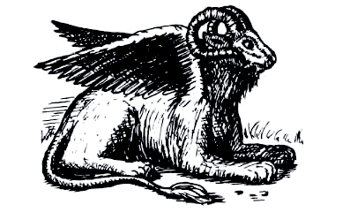
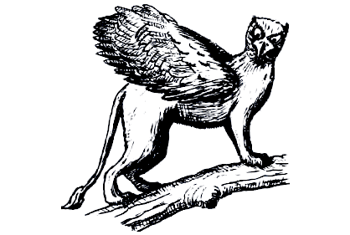
Criosphinx & Hieracosphinx
In addition to the Androsphinx and the Gynosphinx, two cousins of them are introduced in 1E, and... and, wow, considering how cool the sphinxes were in most later-written edition, the 1st Edition entry for them were... bizarre. A brief glance through the entries doesn't really tell you much about them. The Androsphinx's got a dude's head, Gynosphinx's got a lady's head (and tits, because), the Criosphinx's got a ram head and the Hieracosphinx's got an eagle head. The Hieracosphinx's definitely highly redundant considering hippogriffs and griffons and exist in this world, but whatever. Variation, right? And, sure, 1E's Sphinxes didn't have much to do with being guardians of tombs or testing heroes or whatnot. It's fine. The Androsphinx is noted to be a lot dumber and they dislike the Gynosphinxes, because the Gynosphinxes are far smarter than them... but something that is merely implied in 1E's curt descriptions and unfortunately expounded upon in 2E is that the Gynosphinxes need the reclusive, hates-women-because-they-are-smarter Androsphinxes to breed.
Complicating things further is the fact that the Criosphinxes and Hieracosphinxes are basically two asshole sub-types that are noted to "lust after" gynosphinxes in 1E, but in 2E, we get the description on how the criosphinxes will work together in groups to restrain gynosphinxes, and then fight with each other for the rights to mate with the gynopshinx, while the hieracosphinxes will try and work together and kill an androsphinx, then hide in their lair to ambush any gynosphinx that comes across them. How... how the fuck has this race even survived to have enough of a population to sustain this behaviour? And also, why the fuck is this elaborate description even a thing? Like, I would understand it if the mythological basis of a creature does actually have rape or interbreeding in the story. But the sphinxes (and I double-checked) have none. So it's definitely a much-needed retooling of the species in subsequent editions for sure.
Strangle Weed
Going from rapey sphinxes, we go to the Strangle Weed... which is basically yet another aquatic creature that hasn't really seen the light of day after its first appearance. And... uh... it's a sentient kelp that strangles passers-by. That's... that's it. That's the whole point of the Strangle Weed. No origin, no weird powers, no real interesting visual descriptions or lore descriptions. It's just a weed that chokes people. Okay.



Sylph
So we've got dryads, and nymphs, and now we have Sylphs, if you prefer your human-sized fey to have huge butterfly wings and fly around. Depending on the edition, the sylph is either a fey creature, or a creature from the air elemental plane in a similar vein to salamanders. They... they've really not got a whole lot to them, really, and other than being a human-sized Tinker Bell all they've really got going for them is that they move from place to place and are half-decent spellcasters. It's kind of a shame that they never did much with sylphs, really, but with so many lady fairies with wings, I can understand the D&D team really trying to find ways on how to give each of them something unique.
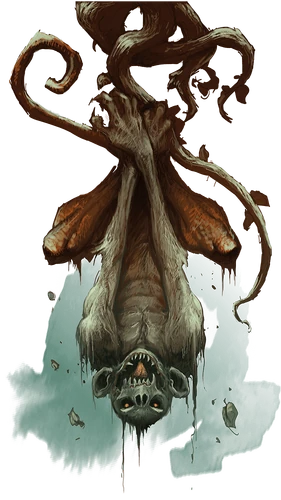
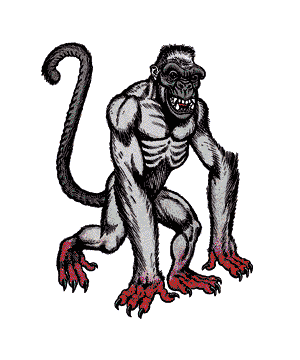
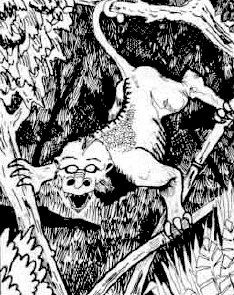
Su-Monster
The Su-Monster shows up in 1E and 2E, but is basically sort of ignored until 5E had them pop up in the Tomb of Annihilation adventure, a book that's unapologetic about reintroducing some of the goofier aspects of the older editions. And the Su-Monster is... it's not my favourite creature, for sure, essentially being a bizarre monster-monkey that sort of lurk around forests and have psionic powers. Oh, and they have red hands. 1E and 2E doesn't really make them super different from just a generic ugly ape, but man oh man that 5th edition artwork with the gangly body and that positively ghoulish face really does make for one hell of a creepy monkey. They apparently love to hang upside-down from trees to maim their prey, and they are sadistic enough to kill more than they can eat, then bury the remains of their victims and using their possessions as trophies. Ultimately, still not quite as interesting as many of the other creatures on this page, but, hey, someone out there probably likes crazy psychic serial killer monkeys. I know I find them unsettling.
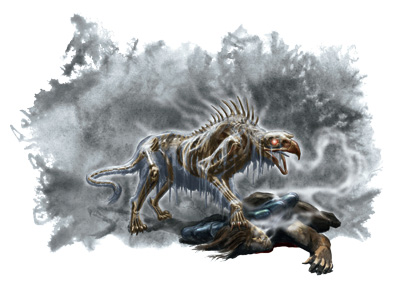
Thought Eater
The Thought Eater is actually a pretty freaking creepy creature that is blessed with a triple-combo of an underwhelming name, a silly-looking artwork and one of those "include this monster to be a dick to your players" mechanic. See, the Thought Eater looks like an emancipated platypus, and it lives completely in the ether -- meaning that without some highly specific magic, your adventurers will have no idea that the Thought Eater is even around. But they can see you, and they can see the psionic users in your party, and can only be attacked by ethereal means, slowly absorbing psionic energy or spells, but at close enough range, they will eat the thoughts of anyone nearby. And, man, moving away from the overly technical 1E description aside, how terrifying would it be to have this ethereal stalker who isn't even malicious, but is just attracted to you, and you have to figure out how to combat it even as your thoughts slowly disappear. Why are you even in this dungeon in the first place? What is a 'thought eater', even? Why am I holding a magical wand? What is a 'I'? Of course, the rules should probably be tweaked a little to make them actually manageable to a party, but still, a ghostly, eldritch fiend in the shape of a grinning, malnourished platypus does make for a pretty creepy creature. Too often, I feel like the Thought Eater keeps making its way into lists of the dumbest D&D monsters as well as lists of hidden gems among the original D&D monsters. Hopefully, like the Flumphs and Modrons, someone in the 5E department would revivify this bizarre beast.
2E and 3E both tried their hand at the Thought Eater, with 2E going with the appearance of a skeletal platypus, and it's noted that they're apparently thought to be the final fate of psionicists once they die. 3rd Edition's Thought Eater is one of the many creatures in the psionics handbook, and... and it's got a neat artwork, but I do admit that it sort of robs the original concept of the Thought Eater on what's unique, making it just a hound-like creature instead of the bizarre, ghostly thought-eating parasite that it used to be. While the 1E version of the concept might be a bit too assholish for gameplay purposes, I actually feel that there's enough wackiness with the concept that they should've given it another go.
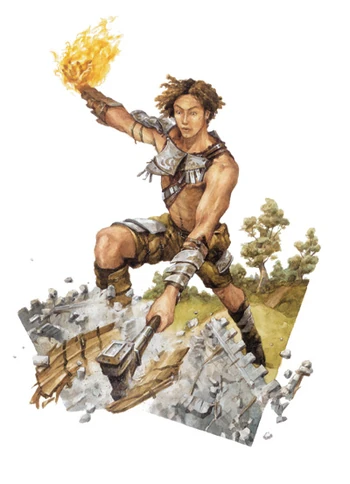
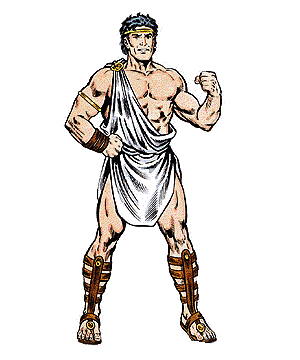
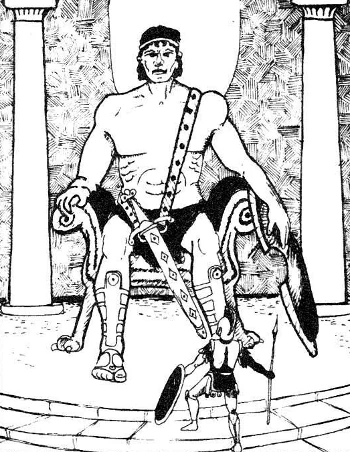
Titan
D&D draws more from the Greco-Roman myths compared to any other real-life mythology, other than maybe Tolkien's work. And I flip-flopped about whether to talk about the Titans when I talked about the Empyreans in 5th Edition, because, well, the Empyreans in 5E are essentially the same as Titans, just with slightly different details in their backstory. Titans in 1E through 3E are basically described as a god-like race, physically resembling giants but far, far mightier, and they tended to descend from their higher planes temporarily into the material plane. 2E and 3E would describe them as being one step away from essentially being gods and celestials, and are essentially bound to emotions moreso than the more patient celestials. In most editions, they have some sort of bond with giants, particularly storm giants. 4E basically had Titan be a title for more powerful variants of regular giants (so a stronger Storm Giant is a Storm Titan), and, well, 5th Edition basically scaled down their power a lot and renamed them as Empyreans. They're a neat nod to real world mythology, but I've personally always found these sort of godlike-but-not-really entities in any fictional world to be pretty samey. Throw in the sheer amount of giants, angels and celestials in D&D, and the Titans are hands-down easily the most boring one out of them, lore-wise and design-wise.
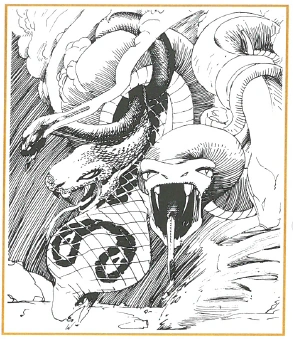 Wind Walker
Wind WalkerOnly appearing in 1E and 2E, the Wind Walker are noted to be beings from the air elemental plane, and they're telepathic. 1E doesn't really give us much in terms of appearance, and I guess we're supposed to assume that they're just generic elementals with greater power. 2nd Edition depicted them as taking the forms of a whirling tornado made out of snakes, and are servitors of the djinn. I'm... I'm not sure why air elementals have anything to do with snakes, but, sure. Uh. Okay. Why not. Snakenado, I guess.
Kind of an underwhelming one to end our review of the 1E Monster Manual on, honestly.
I'm going to go slightly more in-depth with this review of the 1st Edition Monsetr Manual, because, well, it's the first Monster Manual out there, and for better or for worse, so many of what's printed in this very first Monster Manual will end up being treated as, well, 'classic' monsters, and moreso than any other sourcebook, I feel like the 1st Edition really ended up solidifying what monsters will show up in subsequent material, even if they have to be revamped a bit.
Here is a brief list of all the creatures that are included in the Monster Manual, sorted via 'original D&D monsters', 'mythological monsters' and 'real-life creatures or giant variations thereof'. There's, of course, a bit of an overlap between whether, say, an 'ettin' or a 'rakshasa' should be counted among original D&D monsters or as mythological/Tolkienic monsters, considering the D&D version essentially just borrows a name from myth and creates its own version of the creature. Anyway, this is just for my own little organization, to let me the list of monsters a bit better.
Original D&D Monsters:
 Ankheg, Axe Beak, Beholder, Black Pudding, Blink Dog, Bulette, Carrion Crawler, Demons (Demogorgon, Juiblex, Manes, Orcus, Succubus, Vrock, Hezrou, Glabrezu, Nalfashnee, Marilith, Balor, Yennoghu), Devils (Asmodeus, Baalzebul, Barbed Devil, Bone Devil, Dispater, Erinyes, Geryon, Horned Devil, Ice Devil, Lemure, Pit Fiend), Displacer Beast, Dragon Gods (Tiamat, Bahamut), Dragon Turtle, Elemental (Air, Earth, Fire, Water), Ettin, Violet Fungi, Giant Spore, Gelatinous Cube, Gnoll, Gorgon, Gray Ooze, Intellect Devourer, Invisible Stalker, Jackalwere, Lich, Lizardman, , Mimic, Mind Flayer, Neo-Otyugh, Nightmare, Ochre Jelly, Otuygh, Owlbear, Pseudodragon, Piercer, Purple Worm, Quasit, Rakshasa, Remorhaz, Roper, Rust Monster, Sahuagin, Salamander, Shambling Mound, Shrieker, Stirge, Triton, Troglodyte, Umber Hulk, Water Weird, Xorn
Ankheg, Axe Beak, Beholder, Black Pudding, Blink Dog, Bulette, Carrion Crawler, Demons (Demogorgon, Juiblex, Manes, Orcus, Succubus, Vrock, Hezrou, Glabrezu, Nalfashnee, Marilith, Balor, Yennoghu), Devils (Asmodeus, Baalzebul, Barbed Devil, Bone Devil, Dispater, Erinyes, Geryon, Horned Devil, Ice Devil, Lemure, Pit Fiend), Displacer Beast, Dragon Gods (Tiamat, Bahamut), Dragon Turtle, Elemental (Air, Earth, Fire, Water), Ettin, Violet Fungi, Giant Spore, Gelatinous Cube, Gnoll, Gorgon, Gray Ooze, Intellect Devourer, Invisible Stalker, Jackalwere, Lich, Lizardman, , Mimic, Mind Flayer, Neo-Otyugh, Nightmare, Ochre Jelly, Otuygh, Owlbear, Pseudodragon, Piercer, Purple Worm, Quasit, Rakshasa, Remorhaz, Roper, Rust Monster, Sahuagin, Salamander, Shambling Mound, Shrieker, Stirge, Triton, Troglodyte, Umber Hulk, Water Weird, XornTolkien/Mythological Monsters:
Basilisk, Bugbear, Catoblepas, Centaur, Chimera, Cockatrice, Couatl, Djinni, Doppelganger, Dragons (Black, Blue, Brass, Bronze, Copper, Gold, Green, Red, Silver, White), Dwarf, Dryad, Efreeti, Elf (Aquatic elf, Drow, Gray elf, Half-elf, Wood elf), Gargoyle (Gargoyle, Kopoacinth), Ghast, Ghoul, Giant (Cloud, Fire, Frost, Hill, Stone, Storm), Gnome, Goblin, Golem (Clay, Flesh, Iron, Stone), Griffon, Banshee (as Groaning Spirit), Halfling (Tallfellow, Stout), Harpy, Hell Hound, Hippogriff, Hobgoblin (Hobgoblin, Koalinth), Homunculus, Hydra (Lernean Hydra, Pyrohydra), Imp, Kobold, Lamia, Lycanthrope (Werewolf, Werebear, Wererat, Wereboar, Weretiger), Manticore, Medusa, Merman, Minotaur, Mummy, Naga (Spirit Naga, Spirit Naga, Water Naga), Night Hag, Ogre, Ogre Mage (as Japanese Ogre), Orc, Pegasus, Peryton, Pixie, Roc, Satyr, Sea Hag, Shadow, Skeleton, Specter, Androsphinx, Gynosphinx, Sprite, Treant, Troll, Unicorn, Vampire, Wight, Will-O'-Wisp, Wraith, Wyvern, Yeti, Zombie
Real-Life/Giant Animals:
Giant Ant, Ape (Gorilla), Carnivorous Ape, Badger, Baluchiterium, Barracuda, Bear (Brown, Black, Cave), Giant Beaver, Giant Beetle (Bombardier, Boring, Fire, Rhinoceros, Stag, Water), Boar (Wild Boar, Giant Boar, Warthog), Buffalo, Bull, Wild Camel, Wild Cattle, Giant Centipede, Giant Crab, Giant Crayfish, Crocodile, Giant Crocodile, Dinosaur (Anatosaurus, Ankylosaurus, Allosaurus, Brontosaurus, Archelon, Brachiosaurus, Camarasaurus, Ceratosaurus, Cetiosaurus, Dinichtys, Elasmosaurus, Gorgosaurus, Diplodocus, Iguanodon, Lambeosaurus, Megalosaurus, Mosasaurus, Paleoscincus, Monocloinus, Pentaceratops, Plateosaurus, Plesiosaurus, Pteranodon, Stegosaurus, Styracosaurus, Teratosaurus, Triceratops, Tyrannosaurus), Dog (War Dog, Wild Dog), Dolphin, Giant Eagle, Eel (Giant Eel, Weed Eel, Electric Eel), Elephant (Asiatic, African), Flightless Bird, Frog (Giant Frog, Killer Frog, Poisonous Frog), Giant Gar, Giant Goat, Herd Animal, Hippopotamus, Horse (Draft, Heavy, Light, Medium, Pony, Wild), Hyena (Hyena, Hyaenodon), Irish Deer, Jackal, Jaguar, Lamprey, Giant Leech, Leopard, Lion (Mountain Lion, Spotted Lion), Lizard (Fire, Giant, Minotaur, Subterranean), Lynx, Mammoth, Mastodon, Man (Fighter, Magic User, Cleric, Thief, Bandit, Brigand, Berserker, Buccaneer, Pirate, Caveman, Tribesman, Dervish, Nomad, Merchant, Pilgrim), Giant Octopus, Giant Otter, Giant Owl, Giant Pike, Giant Porcupine, Portuguese Man-o-War, Giant Ray (Manta, Pungi, Sting), Giant Ram, Rhinoceros (Rhinoceros, Woolly Rhinoceros), Giant Scorpion, Giant Sea Horse, Sea Lion, Shark (Shark, Megalodon), Giant Skunk, Giant Slug, Giant Snake (Amphisbaenic, Constrictor, Poisonous, Sea, Spitting), Giant Spider (Giant, Huge, Large, Phase, Giant Water), Giant Squid, Stag (Stag, Giant Stag), Giant Tick, Tiger (Tiger, Smilodon), Titanothere, Toad (Giant, Ice, Poisonous), Turtle (Sea, Snapping), Giant Wasp, Giant Weasel, Whale, Wolf (Wolf, Dire Wolf, Winter Wolf), Wolverine (Wolverine, Giant Wolverine)

And... yeah, there are a lot of random giant animals, and, most impressively, a massive amount of random dinosaur stats, which went on and on. The way that the Monster Manual is laid out, we tended to get a massive block of stats and a paragraph that ended to be a mixture of lore-y flavour and random mechanical stuff. It's also interesting that we do get random prehistoric animals like the Baluchiterium and Titanothere quite randomly.
And, well, here's a list of the random trivia I've noted through my read-through of 1E's Monster Manual:
- Some creatures like oozes and genies aren't listed in a single category, which is kind of telling of how the lore for them would evolve over the different editions. Also, some demons and devils like imps and quasits are not lumped together with the rest of their fiend brethren. Note that in the very first printings, all of the lesser demons are just noted as "Type 1", "Type 2" and so on and so forth, with only the Demon Lords having unique names. Later reprints would then add the monikers like Balor and Marilith.
- A lot of the monsters, like the Beholder, mostly end up with the text just describing what the monster can do, and the mechanics of their behaviour, and sometimes with somewhat pedantic percentages of events happening. To paraphrase: two hobgoblin tribes will throw catcalls or derision (85%) and sometimes open fighting might break out (15%). But it's neat to note that even if it's just in a single sentence or an off-handed shrug, things like the Beholder's hatefulness and xenophobia is already there since the very first iteration, it's just that subsequent material would actually build on this and actually give creatures like beholders or the fiends a proper backstory.
- Some monster variants that I didn't cover include Kopoacinth, Water Naga, Mottled Worm and Koalinth, which are basically just gargoyles, naga, purple worms and hobgoblins, respectively, that can breathe underwater. They quite literally only have a sentence to their name. There's also the Neo-Otyugh, which is basically a stronger, slightly-better-at-telepathy version of the Otyugh. Sirens don't have their own entry or even a sub-entry, but it is noted in passing that Harpies that live in coastal regions tended to be called Sirens.
- Some random mentions of real-world countries, like "African Elephant", "Sumatran Rat" and "Japanese Ogre", abound in these descriptions.
- Giant Beavers are actually described to be able to trade and be persuaded to undergo construction if you can convince them. Okay!
- The original Black Pudding is noted to essentially be a colony organism of many, many cells with tiny mouth openings, instead of just being a goopy-goo. The Ochre Jelly is explicitly a giant amoeba.
- I am genuinely impressed at the sheer variety of dinosaurs and their relatives that are listed in the 1E Monster Manual. Lots of the 'basic' pop culture dinosaurs are here, but we even have alternate names for dubiously-identified dinosaurs (Antrodemus for Allosaurus, Trachodon for Anatosaurus...) and even a couple that I've never heard of before like Cetiosaurus and Paleoscincus.
- Dragons actually have some hilarious faux-latin names! Black dragons are Draco causticus sputem (its name is literally 'spit caustic'), brass dragons are Draco impudentus gallus (chicken?), white dragons are the hilarious-sounding Draco rigidus frigidus, gold dragons are Draco orientalis sino dux (it is based on the oriental dragon, after all), and green dragons are Draco cholrinous nauseous respiratorious. These are hilarious.
- Also also, there's a whole section of the dragon page talking about subduing and capturing and selling dragons, which have been quickly dropped from most editions.
- Water Elementals are noted to have to operate nearby a source of water, and will continually take damage outside of their element.
- As noted in previous reviews, the kobolds were 'goblin cousins' in the original 1E, with an appearance that definitely didn't have any sort of reptilian features.
No comments:
Post a Comment